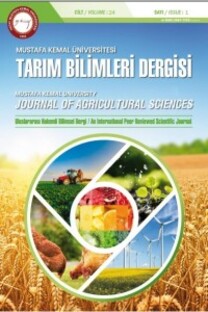Response of okra to water stress
___
Abubaker BMA, Ahadi M, Shuang-En Y, Guang-Cheng S (2014). Different Irrigation Methods for Okra Crop Production under Semi-arid Conditions. International Journal of Engineering Research and Technology, 3 (4): 787-794.Adekiya AO, Agbede TM, Aboyeji CM, Dunsin O (2017). Response of okra (Abelmoschus esculentus (L.) Moench) and soil properties to different mulch materials in different cropping seasons. Scientia Horticulturae, 217: 209-216.
Çalişir S, Özcan M, Haciseferogullari H, Yildiz MU (2005). A study on some physicochemical properties of Turkey okra Hibiscus esculenta L. seeds. J. Food. Eng., 68, 73–78.
Doorenbos J, Kassam AH (1986). Yield response to water. FAO Irrigation and Drainage Paper 33, Rome. pp 193.
Düzyaman E (2005). Phenotypic diversity within a collection of distinct okra Abelmoschus esculentus cultivars derived from Turkish land races. Genet. Resour. Crop Evol., 52, 1019–1030.
Echo (2003). Plant Information Sheet. N.F.T Meyers, USA http://echonet.org/.
FAO (2019). Crop production statistics. Retrieved August 23, 2019, from, www.fao.org.
Gopalan C, Rama Sastri BV, Balasubramanian SC (1989). Nutritive value of Indian foods. National Institute of Nutrition. ICMR, Hyderabad, India.
İnan Y (1996). “Breeding report on the Denizli okra cultivar.” Rep. No.113, Atatürk Central Horticultural Research Institute, Yalova, Turkey.
Martin FW, Rhodes A M, Ortiz M, Diaz F (1981). Variation in okra. Euphytica, 30, 697–705.
MGM, 2019. Meteoroloji Genel Müdürlüğü. Retrieved August 15, 2019, from, https://www.mgm.gov.tr/veridegerlendirme/il-veilceler-istatistik.aspx?k=A&m=TOKAT
Oppong Danso E, Abenney-Mickson S, Sabi EB, Plauborg F, Abekoe M, Kugblenu YO, Jensen CR, Andersen MN (2015). Effect of different fertilization and irrigation methods on nitrogen uptake, intercepted radiation and yield of okra (Abelmoschus esculentum L.) grown in the Keta Sand Spit of Southeast Ghana. Agricultural Water Management, 147: 34-32.
Panigrahi P, Sahu NN (2013). Evapotranspiration and yield of okra as affected by partial root-zone furrow irrigation. International Journal of Plant Production, 7 (1): 33-54.
Siyal AA, Mashari AS, Bristow KL, van Genuchten MTh (2016). Altenative furrow irrigation can radically improve water productivity. Agricultural Water Management, 173: 55-60.
Vural H, Eşiyok D, Duman İ (2000). Kültür Sebzeleri (Sebze Yetiştirme). Ege Üniversitesi Ziraat Fakültesi Bahçe Bitkileri Bölümü, İzmir/Turkiye. 440 s.
Ünlükara A, Kurunç A, Kesmez GD, Yurtseven E (2008). Growth and evapotranspiration of okra (Abelmoschus esculentus L.) as influenced by salinity of irrigation water. Journal of Irrigation and Drainage EngineeringASCE, 134 (2): 160-166.
- ISSN: 1300-9362
- Yayın Aralığı: Yılda 3 Sayı
- Başlangıç: 1996
- Yayıncı: Mustafa Kemal Üniversitesi Ziraat Fakültesi
Elmaların (Malus communis L.) bazı fiziksel değişimlerine farklı kurutma koşullarının etkisi
Bünyamin DEMİR, Cevdet SAĞLAM, Necati ÇETİN
Mehmet Sait KİREMİT, M. Hakan ARSLAN, Alieu SAİDY
Effectiveness of GNSS-based tractor auto steering systems in crop spraying
Mustafa TOPÇUERİ, Muharrem KESKİN
Serdar POLAT, Korkmaz BELLİTÜRK, Meryem METİNOĞLU
Karpuzda farklı sulama programlarının klorofil içeriğine etkisi
Gülşen DURAKTEKİN, Yeşim BOZKURT ÇOLAK, Mete ÖZFİDANER, Alper BAYDAR, Engin GÖNEN
Akdeniz bölgesinde bulunan sulama şebekelerinin kalite indeksi ile değerlendirilmesi
Hasan DEĞİRMENCİ, Sinan KARTAL
C. Sabahattin ONCEL, Mladen TODOROVİC, A. Halim ORTA
Yeşim AHİ, Hüseyin T. GÜLTAŞ, Daniyal D. KÖKSAL, Murat KARAER
Effects of different drying conditions on physical changes of apple (Malus communis L.)
Necati ÇETİN, Cevdet SAĞLAM, Bünyamin DEMİR
Gaziantep ili Nizip ilçesi zeytin bahçeleri topraklarının bor durumunun belirlenmesi
